Services on Demand
Journal
Article
Indicators
-
 Cited by SciELO
Cited by SciELO -
 Access statistics
Access statistics
Related links
-
 Cited by Google
Cited by Google -
 Similars in
SciELO
Similars in
SciELO -
 Similars in Google
Similars in Google
Share
Boletín Científico. Centro de Museos. Museo de Historia Natural
Print version ISSN 0123-3068
Bol. Cient. Mus. Hist. Nat. Univ. Caldas vol.13 no.1 Manizales Jan./june 2009
1 Department of Zoology, Hungarian Natural History Museum, Budapest VIII, Baross utca 13., H – 1088. E-mail: balint@nhmus.hu
Abstract
The genus Airamanna gen. n. (type species: Annamaria columbia Bálint, 2005) is established on the basis of characters provided by male ventral forewing surface (blue reflector and dorsal androconia) and sexually dimorphic ventral wing colouration and pattern. The genus contains three species, which can be distinguished on the basis of male dorsal forewing androconia: A. columbia (Bálint, 2005), new combination, with extensive dorsal forewing postbasal and postdiscal androconia (Columbia); A. rhapsodia (Bálint, 2005), new combination, with extensive hindwing postbasal androconia (Bolivia) and A. rhaptissima (Johnson, 1991), new combination, with reduced androconia in both dorsal wing surfaces (Ecuador and Peru). In Colombia A. columbia is recorded from the regions Cauca-Muchique, Nariño and Valle.
Key words: Annamaria, Airamanna, Colombia, dorsal wing surface androconia, ventral forerwing blue reflector.
ResumenEl género Airamanna gen. n. (especie tipo: Annamaria columbia Bálint, 2005) se estableció basado en los aracteres de la superficie ventral de las alas anteriores del macho (reflector azul y androconia dorsal) y la coloración sexualmente dimórfica a nivel ventral, así como de diseño. El género incluye tres especies las cuales se distinguen en la androconia dorsal de las alas anteriores en los machos: A.columbia (Bálint 2005) nueva combinación, con androconia extensa en el ala anterior a nivel posbasal y posdiscal (Colombia); A. rhapsodia (Bálint 2005) nueva combinación con androconia extensa en el ala posterior a nivel postbasal (Bolivia) y A. rhaptissima (Jonson 1991) nueva combinación, con androconia reducida en la superficie dorsal de ambas alas (Ecuador y Peru). A. columbia se registra para los departamentos de Cauca (Munchique), Nariño y Valle.
Palabras clave: Annamaria, Airamanna, Colombia, androconia en la superficie dorsal alar, reflector azul ventral en las alas anteriores.
INTRODUCTIONThe purpose of this paper in five chapters is (1) to provide a historical account how the gorgeous butterfly named first as Annamaria columbia Bálint, 2005, has been discovered; (2) to present how an anomaly around its generic name has been created; (3) to place this species in a new genus; (4) to discuss the male androconia as important character for species level discrimination in the genus and finally; (5) to summarize the Colombian geographical, spatial and temporal distribution data of A. columbia.
THE DISCOVERYJammed amongst material of "Thecla barajo" and its relatives in the Main Butterfly collection of the Natural History Museum, London (cabinet series 28A, drawer number 68) since almost a century, a large, curious female lycaenid butterfly specimen was curated as an undescribed species by Frederick Goodson (Bálint, 2005a). This situation was recorded in the illustrated catalogue of Neotropical lycaenid butterflies by D'Abrera (1995). The genus Annamaria was established by d'Abrera and Bálint (d'Abrera, 2001) with Thecla draudti Lathy, 1926 as type species.
Subsequently I reviewed the genus Annamaria (Bálint, 2005b) and in the frame of that work the species Annamaria columbia has been described and placed in the original binominal combination on the basis of characters provided by the wings and the body. The holotype of the species became this unique female specimen. In the genus I distinguished three species groups, namely the ganimedes species-group with three species, rhaptissima species-group also with three species and the monotypic columbia species-group. The establishment of columbia and rhaptissima species-groups was based on the logical premise that if the species groups represent the same taxonomic entity, they should have similar biology. This should be mirrored by the ventral wing pattern of the sexes but known only in the case of the ganimedes species-group males and females. Hence than the until not yet known rhaptissima species-group females should have ventral wing underside colouration and pattern similar to those of males; as well as the unknown male of A. columbia should have grey ventral hindwing underside colour with white transferring lines, a pattern known from the female.
THE ANOMALYExpressing the desire to be compatible with a not yet published document Robbins (2002) curiously considered the name Annamaria as being unavailable. He unnecessarily proposed the name "Lamasina" as a replacement of the homonymous and forgotten name Eucharia Boisduval, 1870 (not Eucharia Hübner, 1820, Lepidoptera: Arctiidae). Instead of proposing a new name he should have used the available Annamaria for the document under compilation.
Subsequently Robbins reviewed "Lamasina" inviting Gerardo Lamas, the greatest cataloguer and nomenclatorist of Neotropical butterflies, and tried to annihilate my results flagging the biological species concept (Robbins & Lamas 2008a). Moreover with a joint force and influence they attacked the "validity" of the name Annamaria beside other names also proposed for Neotropical eumaeine lycaenids (Robbins & Lamas 2008b). The positive aspect of their "Lamasina" paper was that the male and female phenotypes of the columbia and rhaptissima species-groups of Annamaria (sensu Bálint, 2005b) were associated and it was pointed out that the concept of columbia species-group was erroneous.
Although it was written by Godman & Salvin for "Thecla nobilis" [=Annamaria draudti] that "it has no very near allies" no worker of Neotropical lycanids was able to recognize the entity I named as genus Annamaria like Godman & Salvin (1887), Draudt (1919) and Goodson (D'Abrera, 1995; Bálint, 2005b). Similarly Annamaria columbia was not distinguished, Although specimens were available (see Robbins in Lamas 2004; Appendix in Robbins & Lamas 2008a). It is also worth to remark here that since the establishment of the genus in 2005 no new information has been communicated or compiled on the biology of these gorgeous butterflies.
AIRAMANNA BÁLINT, GEN. N.Since the revised diagnosis of the rhaptissma species-group I do not consider the ganimedes species-group and the rhaptissima species-group to be congeneric. The hypothesis for that the two species-groups are taxonomically distinct is more plausible than that they are identical. Different optical and scent systems testify divergent biology, what means that ganimedes and rhaptissima species-groups are distinct taxa. Therefore I erect a new genus for the rhaptissima species-group:
Airamanna Bálint, new genus.
Type species: Annamaria columbia Bálint, 2005.
Diagnosis: Airamanna is distinguished (1) by the complex system of dorsal forewing androconia comprised by postbasal, discoidal and postdiscal elements, (2) by an extensive ventral forewing blue reflector (sensu Bálint & Faynel, 2008) covering almost the whole wing surface in males and (3) by sexual dimorphism composed of ventral hindwing pattern unique for eumaine males with large intervenial black pigmental spots in structurally green coloured ground colour, plus ventral hindwing pattern commonplace for eumaeine females with median and postmedian white lines crossing the wing from the costa towards the tornal area.
Relations: Similar system of dorsal forewing androconia can be found in Annamaria (= ganimedes species-group sensu Robbins & Lamas), but it is always supplemented by a tornal scent patch, plus a postbasal ventral forewing androconial system (Bálint, in preparation) (Fig. 1). This complex forewing androconia plus the very short male discal cell is most probably a good indication to the tight relationship of the genera Annamaria and Airamanna. The ventral forewing male blue reflector is restricted caudal to the vein Cubitus 1 in Annamaria (Fig. 2). Similarly large blue ventral forewing reflector can be found in some male eumaeines placed in Atlides and Micandra sections by Robbins (2004) (for example in Atlides sections: Aveexcrenota anna (Druce, 1907), Margaritheclus danaus (Felder & Felder, 1865), Micandra section: Micandra extrema (Draudt, 1919), M. platyptera (Felder & Felder, 1865), Trochusinus balzabamba (Goodson, 1945), T. werneri Salazar, Vélez, Cardona & Johnson, 1997) but there is no further support for a tight relationship between these species and Airamanna. The males of the two known species of Fasslantonis Bálint & Salazar, 2003 (type species: Thecla episcopalis Fassl, 1912) (Hall & Willmott, 2005) possess also an extensive ventral forewing blue reflector. The two or three species of the genus Fasslantonius (Bálint, in preparation) also display sexual dimorphism similar to that of Airamanna: the male ventral hindwing furhter fois comprised by black elements in structurally coloured ground colour associated with commonplace female eumaeine ventral pattern). Further investigations are needed to reveal whether this phenomenon indicates closer relationship or not.
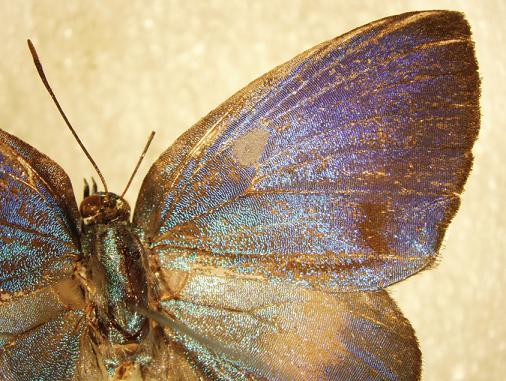
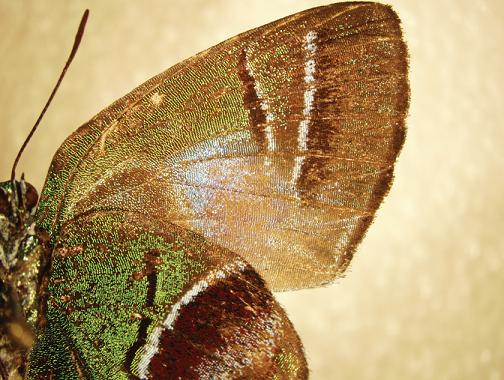
Etymology: The name is an anagram of Annamaria, using to signify the historical connection of the two genera.
DISCUSSIONUsing information providing by wings Airamanna is easily recognizable. Males possess ventral hindwing pattern and colouration unique in neotropical lycaenids (Fig. 3). The genus contains three parapatric Andean species that have distinct androconia and male dorsal wing colouration. Although Robbins and Lamas consider the extension of androconia to be variable, my observations taken in Airamanna and Annamaria contradict their statement.
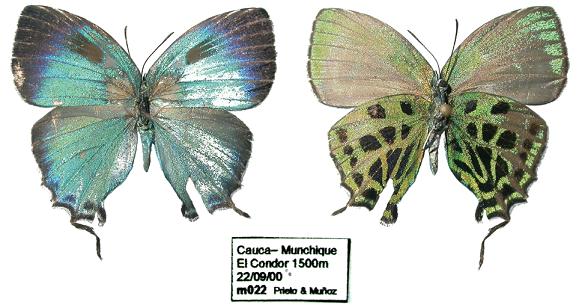
In the case of Airamanna columbia (Bálint, 2005), new combination, the four known individuals (Salazar, 1993: Figs. 2-3; Robbins & Lamas 2008a: Fig. 18, plus two males collected by Carlos Prieto: Fig. 3) have identically large postbasal forewing dorsal scent patch comprised by large brown scales, a large scent pad comprised by small silvery scales in the apex of the discal cell and a postdiscal scent patch of darker brown scales covering medial area bordered by the veins Radius and Media 3 and extending distally along the medial veins (Fig. 4).
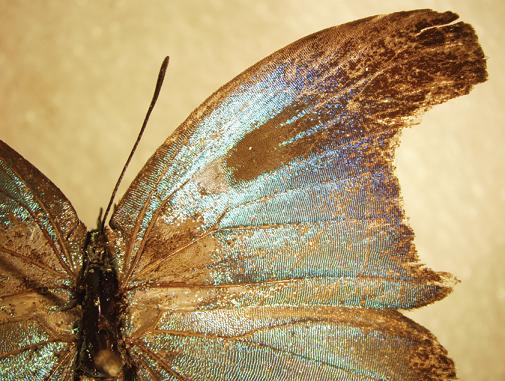
In the case of Airamanna rhaptissima (Johnson, 1991), new combination, the six male specimens known for me (Johnson, 1991: Fig. 31; Bálint, 2005b: Figs. 4-5, 16; D'Abrera, 1995: Fig. "E. mirabilissima"; Robbins & Lamas, 2008a: Fig. 19) have androconial scales dispersed amongst colour rising cover scales in the postbasal area below the vein Cubitus, the scent pad in the apex of the discall cell appears as a minute silvery spot, and the postdiscal androconia is also reduced, but there are androconial scales also dispersed with colour rising cover scales in the discal cell of the dorsal hindwing surface (Fig. 5).
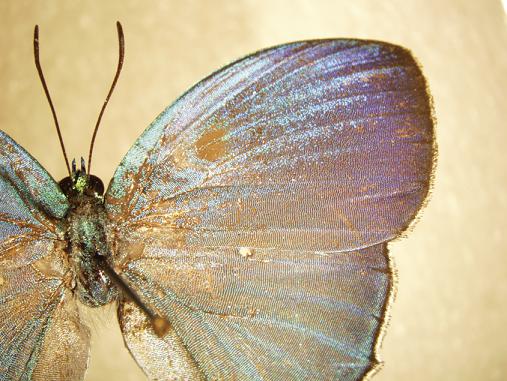
In the series of specimens I discussed above the holotype of Airamanna rhapsodia (Bálint, 2005), new combination, is curious displaying the most complex androconia not recorded in any of the previously mentioned ten specimens: the postbasal area of the dorsal forewing surface has a well visible scent patch below the vein Cubitus, the scent pad situated in the apex of the discal cell large and conspicuous as in A. columbia, the postdiscal scent patch extends into the intercellular areas bordered by the veins Radius, Media 1-3 and Cubitus 1; in the dorsal hindwing surface of the postbasal area between vein Subcosta-Radius 1 and Radial Sector there is a conspicuous scent patch, plus the postbasal area of the discal cell has also androconial scales dispersed amongst colour rising cover scales (Fig. 6).
There are three hypotheses to express the biological importance of this curious androconia: (a) the specimen is aberrant with an aberrant androconia, (b) the rhaptissima holotype represents a distinct taxon with androconia typical for males and (c) the androconia in Airamanna is highly variable and all the three phenotypes have to be considered to conspecific. The most plausible character hypothesis is (b) as the rhapsodia holotype specimen distinctness is supported by other characters (wing shape, colouration and pattern; see the original description in Bálint, 2005b), and it is not intermediate between columbia and rhaptissima recognized also by other workers as distinct taxa. I consider the rhapsodia holotype specimen to be the representative individual of a real taxon.
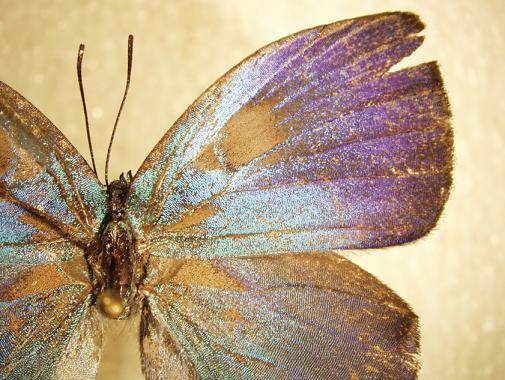
SUMMARY
Striking and spectacular butterflies are good mediums for teaching people to be aware for their environment. These butterflies can be easily selected as target species for supporting nature protection. Most recently, in the case of genus Arcas Swainson, 1832 (type species: Papilio imperialis Cramer, 1775), which was considered to be good indicator of "virgin" ecosystems (Brown, 1993), it was revealed that at least two species living in Colombia are able to colonize secondary habitats (Salazar, 2006; Salazar, 2009, in press).
Airamanna species are most probably good indicators of ecosystems with no or limited human disturbance. Their scarcity in collections can be explained either by rarity caused by low individual numbers of the populations and/or their connection with virgin ecosystems, but it can be also a sign of insufficient sampling method.
There is very little information about the geographical, spatial and temporal distribution of the Airamanna taxa. The records of A. columbia published in the literature are summarized in the followings for an impetus for the future researches:
1. Cauca-Munchique, El Condor, 1500 m, 22 September, 2000 (two male specimens in coll C. Prieto, Calí (Fig. 3.); and Hungarian Natural History Museum, Budapest (Fig. 4.)
2. Nariño, La Planada 1700 m, no further data (male specimen, in coll. Salazar, Caldas; Salazar, 1993),
3. "Santafé de Bogotá", no further data (female specimen in the Natural History Museum, London; Bálint, 2005a),
4. Valle, Calima Dam, 800 m, no further data (male specimen in the Smithsonian Institution, Washington; Robbins & Lamas, 2008a).
5. Valle, Calima, 1200 m, no further data (female specimen in the Allyn Museum of Entomlogy, McGuire Center, Florida Museum of Natural History, University of Florida, Gainesville, Florida; Robbins & Lamas, 2008a).
BÁLINT, Zs., 2005a.,- F. W. Frederick W. Goodson and his contribution to the taxonomy of neotropical hairstreak butterflies (Lepidoptera: Lycaenidae: Eumaeini). Systematics and Biodiversity, 2: 355-373. [ Links ]
__________., 2005b.,- A review of the Neotropical hairstreak genus Annamaria with notes on further genera (Lepioptera: Lycaenidae). Annales historico-naturales musei Nationalis Hungarici, 97: 115-149. [ Links ]
BÁLINT, Zs. & Faynel, C., 2008.,- Taxonomic notes on the Neotropical hairstreak genus Brangas (Lepidoptera, Lycaenidae) with descriptions of six new species and a new genus. Annales historico-naturales musei nationalis hungarici, 100: 271–306. [ Links ]
BROWN, K.S.Jr., 1993.,- Selected Neotropical species, pp. 146-149. In: New, T. R., ed. Conservation Biology of Lycaenidae (Butterflies). Occasional Paper of the IUCN Species Survival Commission No. 8. The IUCN Species Survival Commission, International Union for Conservation of Nature and Natural Resources, Gland, vii + 173 pp. [ Links ]
D'ABRERA, B., 1995.,- Butterflies of the Neotropical region. Part VII. Lycaenidae. Black Rock, Hill House, pp i-xi + 1098-1270. [ Links ]
__________., 2001.,- The Concise Atlas of Butterflies of the World. Melbourne, Hill House Publishers, 353 pp. [ Links ]
DRAUDT, M., 1919.,- Familie: Lycaenidae, pp. 744-831. In: SEITZ, A. (ed.) Die Gross-Schmetterlinge der Erde. Band 5. Alfred Kernen Verlag, Stuttgart. [ Links ]
GODMAN, F.D. & Salvin, O., 1887.,- Biologia Centrali-Americana. Insecta. Lepidoptera-Rhopalocera, Volume 2. Lycaenidae, pp. 1-112. Bernard Quatrich, Duleau & Co., London. [ Links ]
HALL, J.P.W. & Willmott, K.R., 2005.,- A new species of Paiwarria (Lepidoptera: Lycaenidae: Eumaeini) from Western Ecuador. Proceedings of the entomological Society, Washington, 107: 960-967. [ Links ]
JOHNSON, K., 1991.,- Types of Neotropical Theclinae (Lycaenidae) in the Museum National d'Histoire Naturelle, Paris. Journal of the Lepidoperists' Society, 45: 142-157. [ Links ]
ROBBINS, R.K., 2002.,- Replacement names in the Eumaeini (Lepidoptera: Lycaenidae: Theclinae). Proceedings of the entomological Society, Washington, 104: 820-821. [ Links ]
__________., 2004.,- Lycaenidae. Theclinae. Tribe: Eumaeini, pp. 118-137. In: LAMAS, G., (ed.) Checklist: Part 4A. Hesperioidea – Papilionoidea. In: HEPPNER, J.B. (ed.) Atlas of Neotropical Lepidoptera, Volume 5A. Gainesville, Association for Tropical Lepidoptera, Scientific Publishers; xxvi + 439 pp. [ Links ]
ROBBINS, R.K. & Lamas, G., 2008a.,- Nomenclature, variation, and the biological species concept in Lamasina (Lycaenidae: Theclinae: Eumaeini). Resvista Brasileira de Zoologia, 24: 116-127. [ Links ]
__________., 2008b.,- Case 3458; Balintus D'Abrera, 2001, Gulliveria D'Abrera & Bálint, Salazaria D'Abrera & Bálint, 2001, Megathecla Robbins, 2002 and Gullicaena Bálint, 2002 (Insecta, Lepidoptera, Lycaenidae): proposed establishment of availability. Bulletin of the Zoological Nomenclature, 65: 188-193. [ Links ]
SALAZAR, J.A., 1993.,- Noticias sobre seis raras especies de licénidos colombianos. Descripción de una nueva especie de Riodininae para Colombia (Lepidoptera: Lycaenidae). Shilap, Revista de Lepidopterologia 21: 47-53. [ Links ]
__________., 2006.,- Nomenclatural notes of Arcas splendor Druce, 1907 in Central Colombia with comments on territorial behaviour and perching locations (Lepidoptera: Lycaenidae). Boletín Científico, Centro de Museos, Museo de Historia Natural, Caldas, 10: 209-202. [ Links ]
__________., 2009., in press.,- Notes on the territoriality and perching sites of Arcas imperialis (Cramer) in Colombia (Lepidoptera: Lycaenidae). Boletín Científico, Centro de Museos, Museo de Historia Natural, Caldas, 12. [ Links ]














